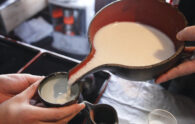On October 26th, 2019, the “Science and Engineering Challenge for High School Students in Iwate for the ILC” was held in Iwate Prefecture.
I was actually the main planner and operator of the contest (I’m with the Bureau of ILC Promotion at the Iwate government), so I’d like to report on not just the contest results, but also some behind-the-scenes as well as my own personal thoughts about the event.
Why we held this contest
Raising motivation, and training young people to become researchers and engineers that can lead at the future ILC
This was the first year we held the contest, aiming for the following goals:
○ In order to realize the ILC, the world’s most advanced research facility of its kind, we need to cultivate human talent that can work there, with a long-term view of accumulating the world’s greatest minds and talents in this area. This contest aims to improve STEM education, with a focus on ILC-related research, and other fields within science and engineering.
○ Through this project, students will get an opportunity to think about the various ways they can move forward with their education, and it will produce talented STEM majors as well as lead to an improvement in the “Iwate Brand.”
Furthermore, it would be just wonderful if our young people, born and raised in Iwate, get to work at the ILC as researchers and engineers – right here in Tohoku, Japan.
So, what was the contest like?
Here’s how the contest worked:
○ Iwate high school students had to present their research in the field of physics, chemistry, or engineering. (Their research topic was up to them)
○ Presentations consisted of them creating and explaining poster about their research, and then making a presentation using Powerpoint.
○ Within their presentation, they had the option to get extra points by making suggestions or giving their opinions for how their research results could be used at the ILC or at the construction of the ILC in Iwate.
Of course, the star of this contest was the fact that the team that got the most points (gaining 1st place and the Iwate Prefecture Governor’s Prize) would get to go to CERN, world’s largest physics laboratory, to participate in an observatory field trip. You could say that this was a science/engineering contest quite unique to Iwate and its goal of realizing the ILC.
A gathering of brilliant young minds in Iwate
Participating teams are formed
We put the call out for teams throughout June and July 2019.
I wanted as many high school students to participate as possible, so I visited over ten high schools during that time to ask teachers to put together teams for the contest.
Some schools agreed right away to put together teams, but I got a reply or two that said, “This is the first time ever for this contest, so we’re not sure if we will participate or not.” I was worried about the contest, but in the end, I received submissions from six teams from four schools (23 students in all) – Morioka Daiichi, Morioka Daisan, Mizusawa, and Kamaishi.
Surprisingly, all of those six teams selected physics as their research topic, with none focusing on chemistry or engineering.
I’d like to express my gratitude to those 23 students who participated in this first contest, and I commend their ambition, passion, and willingness to try new things.
Guiding and following up with these teams before the contest
In the three months from July to the competition in October, each team had to compile research, conduct experiments, and work on their presentation materials, but I worried that some teams might be unsure of how to push forward their research, or how to make their materials.
That’s why in September, I joined with Prof. Masakazu Yoshioka (visiting professor at Iwate University, judge at the contest, and an expert in particle physics) to check in with the teams and see how they were proceeding with their research, as well as to give them advice about how to go forward. We were also there to answer any questions they had about the contest, along with any other science-related questions. We made this effort so that each team could be satisfied with how their final presentation came out, and so that this could be the best contest possible.
The day of the contest
Who would be the team to win the grand prize CERN trip?
The contest was held on October 26, Saturday, on a crisp Japanese fall day.
【Venue】
Techno Hall, Faculty of Science and Engineering, Iwate University (Morioka City, Iwate)
【Program】
| 10:30-10:45 | Opening ceremony | |
| 10:45-12:00 | Poster presentations, judging | |
| 12:00-13:00 | (Break/Lunchtime) | |
| 13:00-15:05 | Research presentations, judging | |
| 15:10-16:10 | Teams and judges (experts) meet for exchange and advice | |
| 16:20-16:30 | Judging results, final evaluations | |
| 16:30 | Closing ceremony |
【Participating Teams and their research】
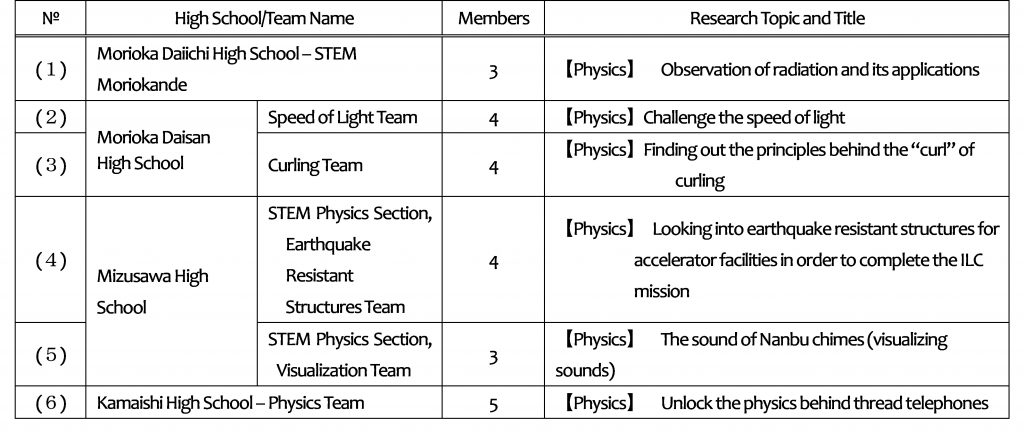 In the morning, we had the poster presentations and judging.
In the morning, we had the poster presentations and judging.
Five judges went to each team and their poster to hear students talk about their research. They asked questions and then made their evaluations.
Some of the students were nervous – they had to explain in simple terms to the listeners about their research, and then accurately answer questions from five experts (the judges)! But each team was able to calmly talk about their research in clear terms.
Some teams even came up with clever ways to show off their research, such as bringing the equipment/tools they used in their research.
Next, we had the Powerpoint presentations in the afternoon. Each team had 15 minutes to present their goals, observations, processes, results, and conclusions. Following, they received questions and comments from the judges.
Observing radiation, measuring the speed of light, researching mechanisms that behind thread telephones – each team’s topic was selected with originality in mind. They explained their research as well as suggested how they could use those results at the ILC.
The judges asked each team about the details of their experiments, why they chose their research themes, and what research they’d like to do in the future. During these question and answer sessions, I saw discussions arise between the high school students and experts about physics research and the ILC.
Then, all the presentations had ended, and the final evaluations were made.
It was very hard to choose between the different teams, but the final results were in – the grand prize (Iwate Prefecture Governor’s prize) was won by the team that presented on the “Observation of radiation and its applications” – the Morioka Daiichi High School STEM Moriokande Team!
Thanks to their win, this team will get to go on the trip to CERN in Europe in March 2020. Congratulations!
About Morioka Daiichi and their topic “Observation of radiation and its applications”
“We wanted to make elementary particles and radiation visible, even though you normally can’t see them. We created a cloud chamber using tissue, plastic wrap, and other everyday items. Our presentation was on how you can intercept alpha waves, and we’d like to do further experiments with beta waves in the future.”
In conclusion, the participating students gave comments like
“The other teams’ view points and perspectives were great reference to us.”
“Through participating in this contest, I gained more interest in science and the ILC.”
“I’d like to get involved with particle physic in the future.”
From the judges,
“I could see the passion for science and research in the students that participated in this contest.”
“There is a lot of interesting and wonderful things within the students’ viewpoints and perspectives.”
I think there was a lot to be gained by the participants and all other people involved.
The Iwate Prefectural Government will continue to try many different things to train and produce people who can take the lead at the ILC in the future.
Japanese
来たれ未来のILC研究者&技術者!~「いわての高校生 サイエンス&エンジニアリング チャレンジ・コンテスト for ILC」初開催!~
2019年10月26日(土)、ILC(国際リニアコライダー)の誘致実現を目指している岩手県で、「いわての高校生 サイエンス&エンジニアリング チャレンジ・コンテスト for ILC」(以下「当コンテスト」という。)が開催されました。
今回のK-TIMES記事は、当コンテスト開催結果のみならず、当コンテストの企画・運営を担当した筆者(岩手県ILC推進局所属)の業務記録、感想、エピソードなどを交え、レポートします。
当コンテストの開催目的 ~モチベーションの向上と将来ILCを担う研究者・技術者の育成~
当コンテストは今年初めて開催されたコンテストであり、その目的は次のとおりです。
○ 世界最高・最先端の研究施設であるILCの実現に向けて、頭脳集積・人的集積に通じる中長期的な視点での人材育成が必要であることから、ILCに関する研究をはじめ理学系・工業系の県内の理数教育の充実を図る。
○ 本事業を生徒自身が多様な進路を考えるきっかけとし、優秀な理科系人材の輩出や本県ブランドの向上の契機となることを図る。
そして、将来、岩手県で生まれ育った多くの若者が、研究者や技術者として、日本の東北の地のILC研究所・関連施設で活躍できれば素晴らしいですね!
当コンテストの実施内容とは?
当コンテストの実施内容は、次のとおりです。
○ 岩手県内の高校生が、物理、化学又は工学に関する研究成果を発表(研究テーマは自由)。
○ 発表形式は、研究概要を記載したポスターの説明及びパワーポイント使用によるプレゼンテーション。
○ 発表の内容に、研究等の成果がILCへ又は岩手県にILC研究施設が設立された際にどう生かすことができるかに係る提言、意見等が含まれている場合、審査得点が加点されるといったオプション付き。
また、何と言っても当コンテストの目玉は、研究発表の審査得点が第1位(岩手県知事賞)となったチームは、世界最大規模の素粒子物理学の研究所であるCERN(欧州原子核研究機構)への視察研修に参加できるというものであり、まさに、ILCの実現を目指す岩手県オリジナルの科学・工学コンテストであると言えるでしょう。
集いし岩手県の若き精鋭たち ~出場チームの決定~
2019年6月上旬から7月中旬にかけて、当コンテストの出場チームの募集が行われました。
「より多くの高校生に出場していただきたい。」との思いから、筆者は、この出場チーム募集期間に10校を超える高校を訪問のうえ、担当の先生方にコンテスト出場をお願いに伺いました。
「ウチの高校からは出場しますよ。」と確約のあった高校もある一方、「(コンテストが)今年初めての開催なので、出場するかどうか迷っている。」と回答した学校もあり、出場校が集まるか不安になったこともありましたが、最終的には、盛岡第一、盛岡第三、水沢及び釜石の4つの高校から6チーム(23名)の応募がありました。
なお、応募のあった全6チームとも、研究テーマは物理に関するものであり、意外にも化学・工学に関するテーマはゼロという結果でした。
今年初めて開催されるコンテストに応募した、この23名の高校生の挑戦、熱意、チャレンジ精神に対し、改めて敬意と感謝を表します。
当コンテスト開催前における出場チームへの指導とフォロー
7月の出場応募から10月のコンテスト開催日までの3か月間、各出場チームは実験・研究及び当コンテストでの発表用資料の作成を進めていきますが、中には実験・研究の進め方に悩んだり、どのような資料を作っていいか分からないチームもあるかもしれません。
そこで、9月に、当コンテストの審査委員長で素粒子物理学の専門家でもある吉岡正和 岩手大学客員教授と筆者が、各出場チームの学校を訪問し、実験・研究の進捗状況を確認するとともに、研究の進め方のアドバイスの提供や当コンテストに関することやその他科学一般に関する質問・相談を受け回答するなど、各チームが満足いく研究発表をできるよう、また、より良いコンテストとなるよう努めました。
そしてコンテスト当日 ~CERN派遣研修を掴み取るチームは?~
日本では秋が深まってきた10月26日(土)、当コンテストの開催日となりました。
【会 場】
岩手大学理工学部テクノホール(岩手県盛岡市)
【当日のプログラム】
10:30~10:45 開会式
10:45~12:00 研究内容ポスター発表・審査
12:00~13:00 (休憩・昼食)
13:00~15:05 研究発表プレゼンテーション・審査
15:10~16:10 出場チームと審査員(有識者)との交流会・アドバイスタイム
16:20~16:30 審査結果発表・全体講評
16:30 閉会・終了
【出場チーム名と研究発表テーマ】
(1) 盛岡第一高等学校 理数科モリオカンデ 3名 【物理】 放射線の観察とその応用
(2) 盛岡第三高等学校 光速班 4名 【物理】 Challenge the speed of light(光速度の測定について)
(3) " カーリング班 4名 【物理】 カーリングのカールの原理を突き止めよう
(4) 水沢高等学校 理数科物理班 耐震構造チーム 4名 【物理】 ILCのミッションを成し遂げるための加速器施設の耐震構造を探る
(5) " 理数科物理班 可視化チーム 3名 【物理】 南部風鈴の音(音の可視化について)
(6) 釜石高等学校 物理班 5名【物理】 糸電話を物理的に解明しよう
午前中は、研究内容ポスターの発表・審査です。
5人の審査員が各チームのポスター掲出場所を巡回し、ポスターの内容(研究の概要)の説明を受け、質疑応答を行い、審査を行う方式です。
自分たちが行った研究内容を聞き手に分かりやすく説明し、5人の有識者(審査員)からの質問に的確に答えなければならないことから、緊張している様子の生徒の姿もありましたが、どのチームも堂々と、明瞭な説明を行うことができました。
また、研究時に使用した機材・道具などを持参し、それらを提示しながら詳細を話すといった、説明方法に工夫が見られるチームもありました。
続いて、午後は、パワーポイントの使用による研究内容のプレゼンテーションです。各チーム15分以内で、研究の目的、考察、プロセス、研究結果・結論について説明し、その後、審査員からの質問・コメントを受ける方式で進められました。
放射線の考察、光速度の測定、糸電話の音声伝播メカニズムを探る実験など、各チームがオリジナリティを持って選択したテーマ・研究に関して説明を行い、ILCへの研究成果の応用や提言なども行いました。
審査員からは、各チームに対し、実験方法の詳細に関すること、研究テーマを選んだ動機、今後どのような研究を行いたいかなどについて質問があり、質疑応答時間は、物理研究・ILCに関する高校生と有識者とのディスカッションの雰囲気を呈していました。
そして、すべての研究発表が終了し、審査結果の発表となりました。
どのチームも甲乙付け難く、難しい審査でありましたが、厳正な審査の結果、第1位(岩手県知事賞)を受賞したのは、「放射線の観察とその応用」について説明を行った盛岡第一高等学校 理数科モリオカンデ チームでした。
これにより、同チームは、2020年3月に実施される欧州CERN派遣研修に参加することとなりました。おめでとうございます!
【盛岡第一高等学校:「放射線の観察とその応用」の概要】
直接見ることのできない素粒子や放射線の見える化に取り組み、自作の霧箱による実験でティッシュやラップなどの日常品を用いて、α線を遮断できることを説明し、今後はβ線も対象にしてさらに実験を推し進めたい、といった内容でプレゼンテーションを行いました。
最後に、参加した高校生からは「他チームの研究に関する視点・考え方が参考になった。」「コンテストに参加することで、科学への興味・ILCへの関心が増した。」「将来は素粒子物理学に携わりたい。」といった意見・感想が聞かれました。
また、審査員からも「今回コンテストに参加した高校生の科学・研究に対する熱意を感じ取ることができた。」「高校生の視点・考え方には感心するところ・素晴らしいものがある。」とのコメントもあり、参加者・関係者共々、大変得るものが多かったように思えます。
岩手県では、より多くの「未来のILCを担う人材」を育成・輩出できるよう、今後も様々な取組を行っていきます。

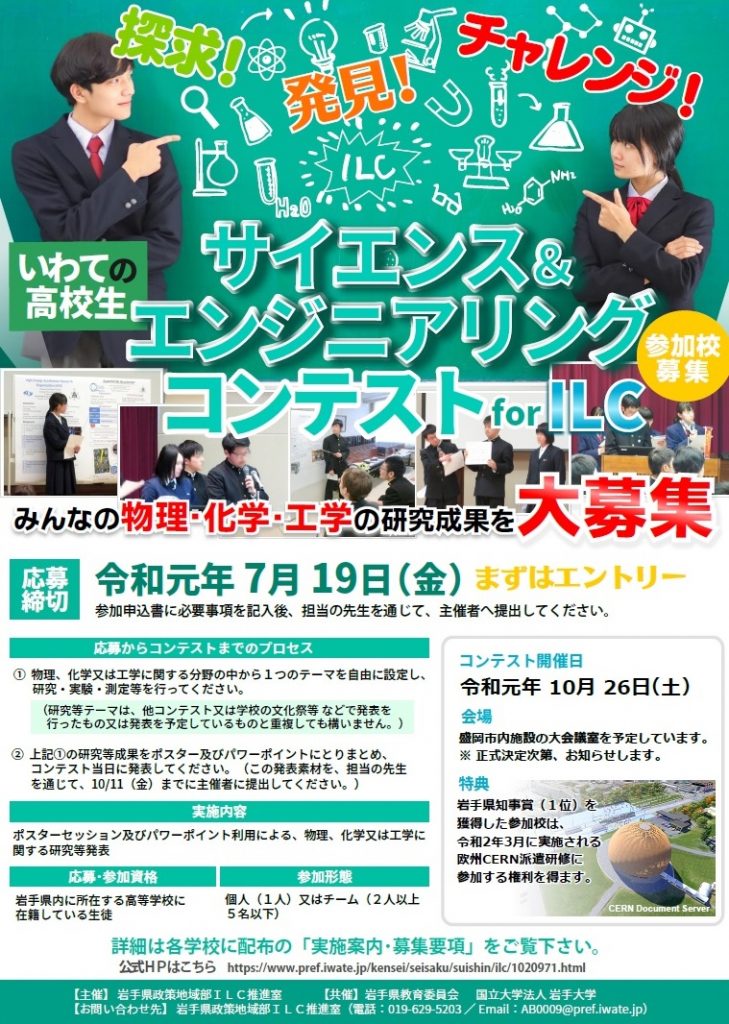
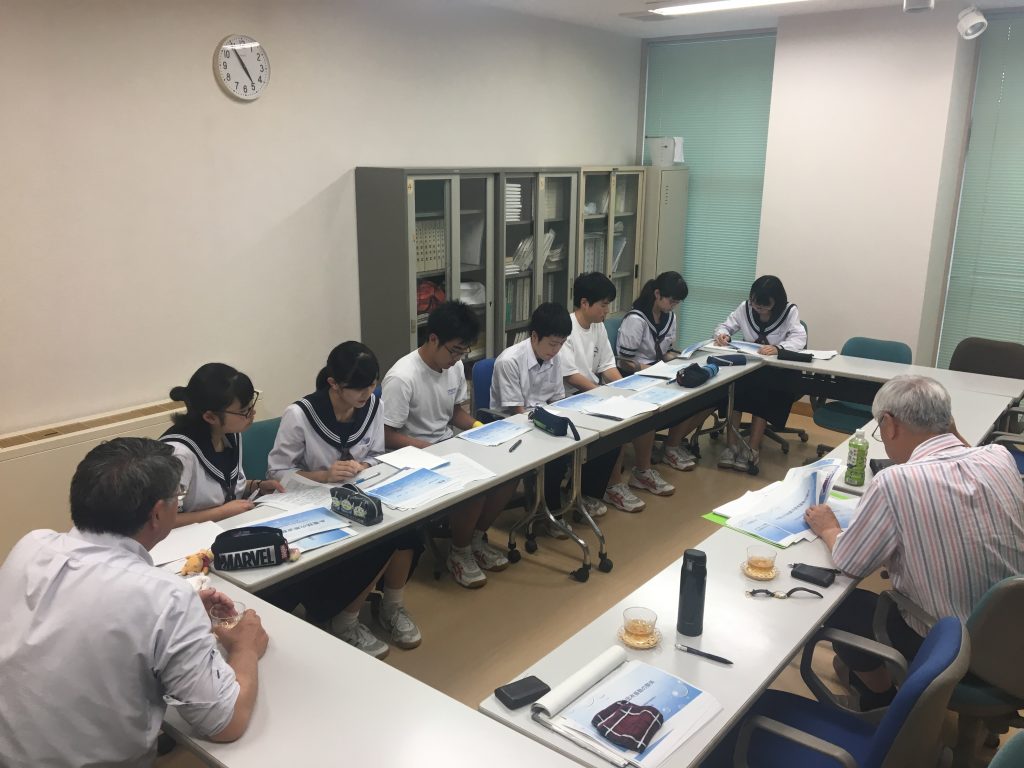
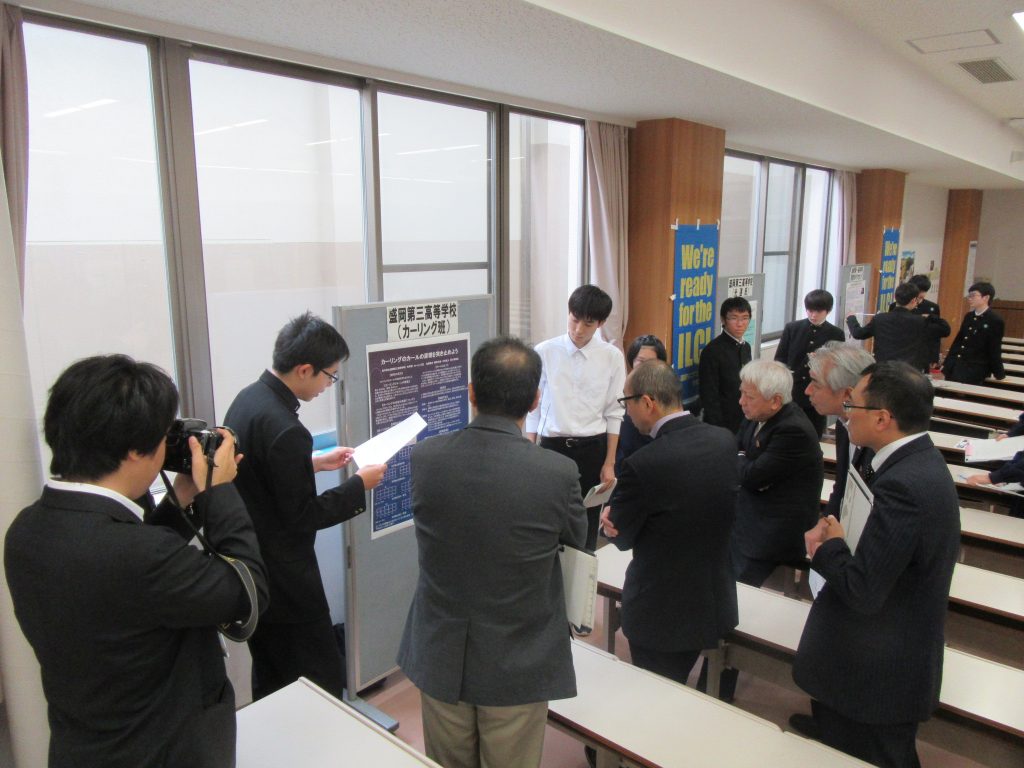
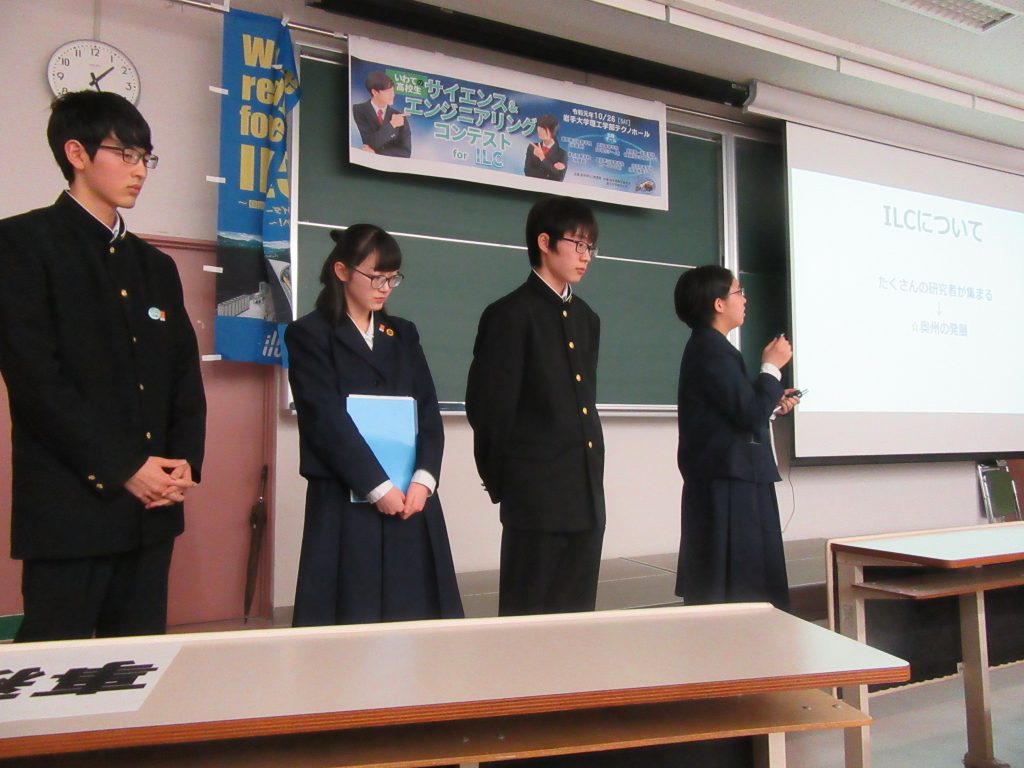
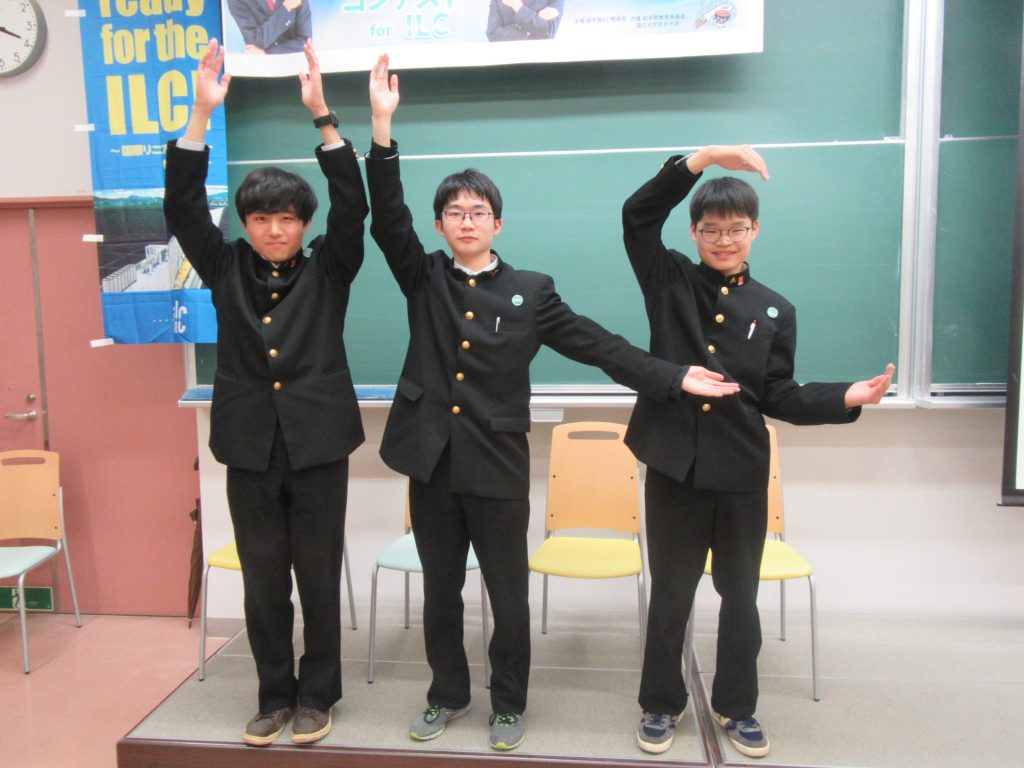
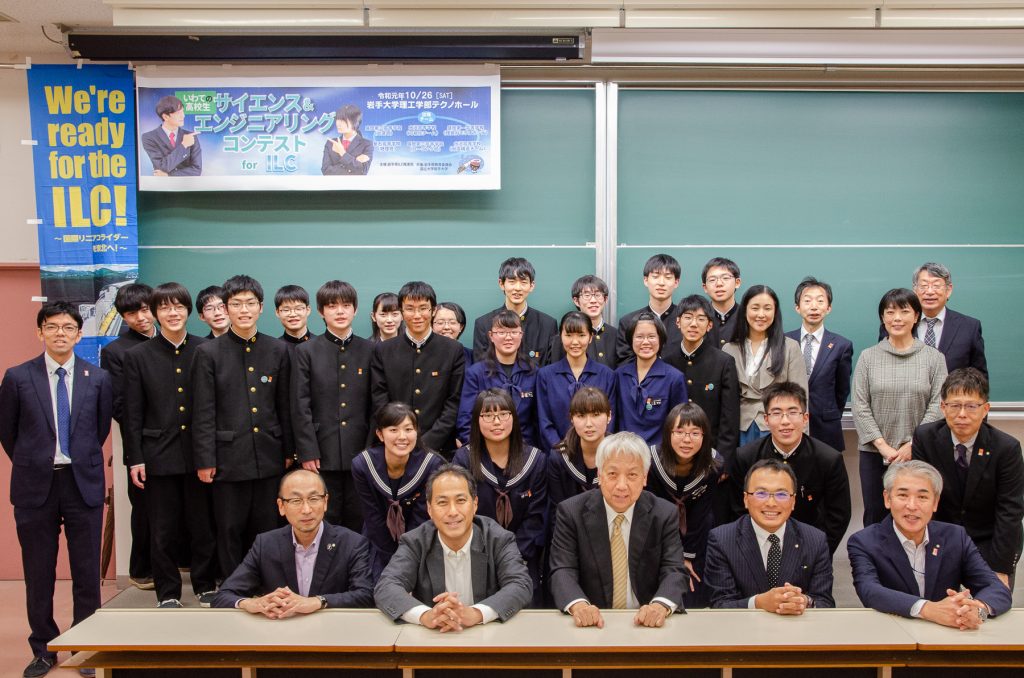
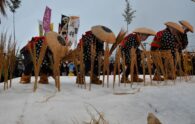
-195x124.jpg)
